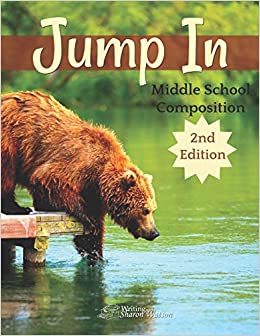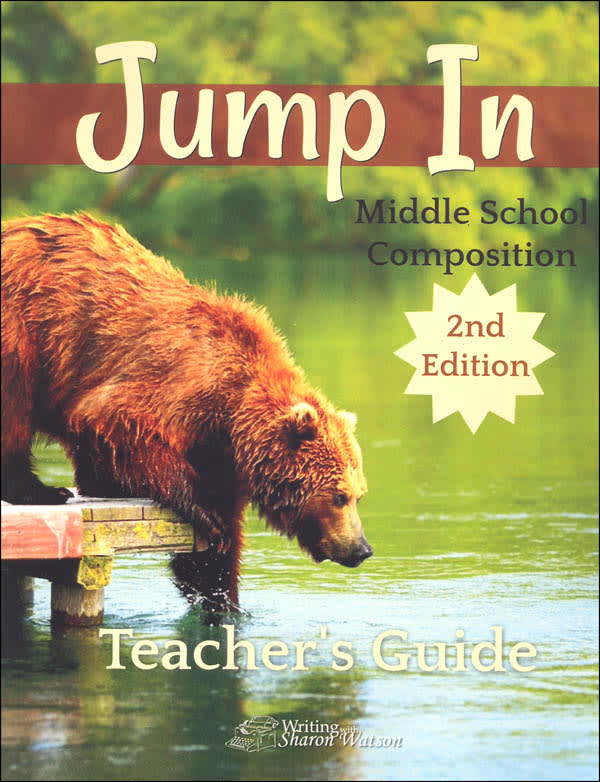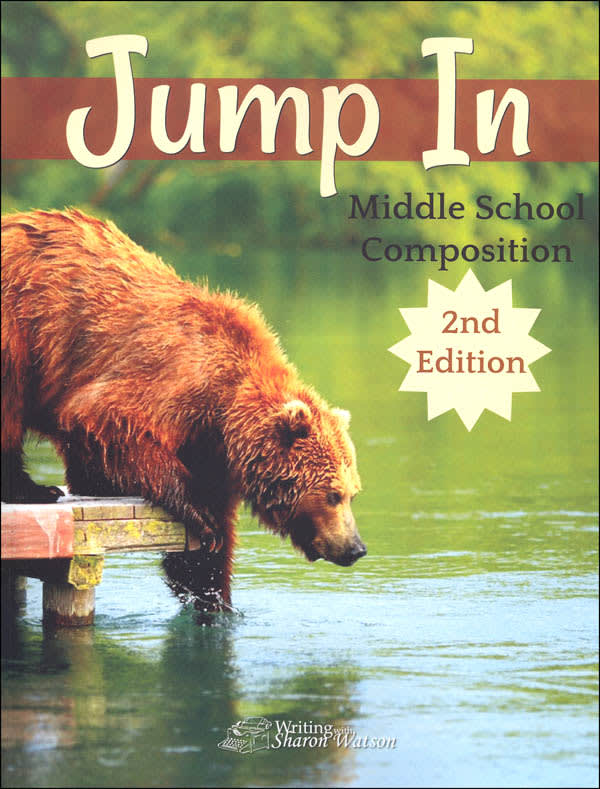Jump In is a writing course for middle school students that provides instruction that covers the steps from brainstorming ideas for a short essay all the way through writing a research paper with a works-cited page. While the course is most appropriate for grades six through eight, it can also be used with high schoolers who need either more work on basic writing skills or a user-friendly approach to motivate them to improve their skills.
The course consists of a consumable student book and a teacher's guide. Both are essential. The teacher's guide describes options for a one-, two-, or three-year plan for completing the book.
The 288-page student book includes instruction, activities, and assignments, plus helpful reference tools at the back. Illustrations and graphic designs break up the content and keep students from getting overwhelmed by too much text.
Written particularly for homeschoolers, this course is designed for students to work independently most of the time. It also assumes a Christian audience with its references to favorite Bible verses, church activities, judgments about Greek gods and goddesses, the spiritual motivations of characters in stories, and other Christian experiences and attitudes.
Author Sharon Watson uses an informal, friendly tone in the lessons. For instance, she opens the lesson on paragraphs and topic sentences with this:
Do you have trouble coming up with ideas to put in your paragraphs? Would you like help organizing a paragraph so it is not a jumbled-up mess? A paragraph is all about one idea. The topic sentence tells readers what that one idea is. The rest of the paragraph explains what you mean, gives examples, or proves why you think your idea is a good one.
The assignments are presented in 13 chapters of varying length that cover pre-writing skills, paragraph writing, opinion writing, persuasive writing, and cause-and-effect writing, as well as how to write a biography, a newspaper or how-to article, a compare-and-contrast essay, a book report or response, a descriptive piece, a narrative, a research report, and poetry. Within these chapters, 98 daily lessons are presented as a series of skills so that students approach each type of writing in bite-sized chunks. In addition to the 98 lessons, there are 19 writing assignments and checklists to be completed. Plenty of examples are included for the various types of writing.
For most of the lessons, students will write directly in their workbooks, spending five to twenty minutes per lesson on writing activities. I particularly like the way Watson has interspersed activities throughout the instruction to ensure that students are processing and applying what they learn. At the end of each group of skill lessons, students are given a number of writing assignments from which to choose. Some of the lengthier assignments might take anywhere from two to ten days to complete and will likely be done either in a notebook or on the computer. Checklists are included that teach students how to proofread their own assignments. The checklists are tailored to fit the different assignments.
Jump In covers so much that it would be difficult to complete all of the lessons in one year. The two- and three-year plans recommend how much you might tackle each year.
The content of the course is significantly expanded beyond the student book with the “10-Minute Writing Plunges” found in the teacher's guide. The Writing Plunges are writing prompts (four per week for September through May) for ten-minute writing assignments to be completed daily, Monday through Thursday. On Friday, students select their favorite Writing Plunge paper for that week and polish it to be turned in on the following Monday.
It would probably be too demanding to have students complete all of the Writing Plunges while simultaneously working through lessons in the student book every day. The three suggested course schedules in the teacher's guide suggest how you might intermix the lessons in the student book with Writing Plunges. Of course, you are welcome to come up with your own schedule for the lessons and Writing Plunges if the suggested plans don't suit you.
Students will need separate instruction in grammar. Sharon Watson has created some free grammar tutorials that you can download to work on specific areas.
The 117-page teacher's guide does not have reproductions of the lessons that are in the student book. Instead, the teacher's guide offers tips for helping if students have problems as they work independently. There are sometimes assignment options for both new and experienced writers. The teacher's guide also has answers for the activities when they are predictable. I think that the most significant feature in the teacher's guide is its extensive help for evaluating student work. It tells how to evaluate and provides examples. Most helpful is the section titled Grading Grids with reproducible forms that help the teacher evaluate the content, grammar, and mechanics of each assignment with questions such as, "Do the title and introduction interest the reader?" (worth 1-5 points), "Are the paragraphs arranged in an effective order? Are there transitions between the paragraphs?" (worth 1-5 pts), and "How are the spelling, capitalization, punctuation, sentence fragments, run-ons, and so on?" (worth 1-25 points). The Grading Grids are individualized for each assignment. These grading tools are very helpful for the parent or teacher.
Summary
Jump In makes it easy for even the inexperienced parent or teacher to provide excellent instruction in composition skills. And students should find the bite-size lessons very manageable.










